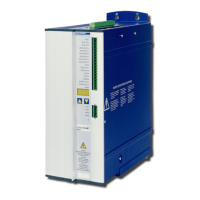4.3 Definition of the used data types
This chapter defines the data types that are used. Each data type can be described by bit-
sequences. These bit-sequences are grouped into "Octets” (bytes). The so-called "Little – Endian”
format (also known as "Intel format") is used for numerical data types (see also: DS301 Applic-
ation Layer "General Description of Data Types and Encoding Rules”).
4.3.1 Basic data types
4.3.1.1 Unsigned Integer
Data in the basic data type UNSIGNEDn define exclusively positive integers.
The value range is from 0 ... 2
n
-1. The bit sequence b = b0 ... b
n-1
defines the value
UNSIGNEDn(b) = b
n-1
2
n-1
+ ... + b
1
2
1
+ b
0
2
0
Example: the value 266 = 10Ah is transmitted in the data type UNSIGNED16, in the form of two
octets (1st octet = 0Ah, 2nd octet = 01h).
Transmission syntax for the data type UNSIGNEDn
Octet number 1. 2. 3. 4. 5. 6. 7. 8.
UNSIGNED8 b
7
..b
0
UNSIGNED16 b
7
..b
0
b
15
..b
8
UNSIGNED24 b
7
..b
0
b
15
..b
8
b
23
..b
16
UNSIGNED32 b
7
..b
0
b
15
..b
8
b
23
..b
16
b
31
..b
24
UNSIGNED40 b
7
..b
0
b
15
..b
8
b
23
..b
16
b
31
..b
24
b
39
..b
32
UNSIGNED48 b
7
..b
0
b
15
..b
8
b
23
..b
16
b
31
..b
24
b
39
..b
32
b
47
..b
40
UNSIGNED56 b
7
..b
0
b
15
..b
8
b
23
..b
16
b
31
..b
24
b
39
..b
32
b
47
..b
40
b
55
..b
48
UNSIGNED64 b
7
..b
0
b
15
..b
8
b
23
..b
16
b
31
..b
24
b
39
..b
32
b
47
..b
40
b
55
..b
48
b
63
..b
56
4.3.1.2 Signed Integer
Data in the basic data type INTEGERn define both positive and negative integers.
The value range is from -2
n-1
-1 ... 2
n-1
-1. The bit sequence b = b
0
..b
n-1
defines the value
INTEGERn(b) = b
n-2
2
n-2
+ ... + b
1
2
1
+ b
0
2
0
with b
n-1
= 0
Negative numbers are represented as 2’s complement, which means:
INTEGERn(b) = - INTEGERn(b) - 1 with b
n-1
= 1
Example: the value -266 = FEF6h is transmitted in the data type INTEGER16, in the form of two
octets (1st octet = F6h, 2nd octet = FEh).
Transmission syntax for the data type INTEGERn
Octet number 1. 2. 3. 4. 5. 6. 7. 8.
INTEGER8 b
7
..b
0
INTEGER16 b
7
..b
0
b
15
..b
8
INTEGER24 b
7
..b
0
b
15
..b
8
b
23
..b
16
INTEGER32 b
7
..b
0
b
15
..b
8
b
23
..b
16
b
31
..b
24
INTEGER40 b
7
..b
0
b
15
..b
8
b
23
..b
16
b
31
..b
24
b
39
..b
32
INTEGER48 b
7
..b
0
b
15
..b
8
b
23
..b
16
b
31
..b
24
b
39
..b
32
b
47
..b
40
INTEGER56 b
7
..b
0
b
15
..b
8
b
23
..b
16
b
31
..b
24
b
39
..b
32
b
47
..b
40
b
55
..b
48
INTEGER64 b
7
..b
0
b
15
..b
8
b
23
..b
16
b
31
..b
24
b
39
..b
32
b
47
..b
40
b
55
..b
48
b
63
..b
56
4.3.2 Mixed data types
Mixed data types combine basic data types (INTEGERn, UNSIGNEDn, REAL). Two types of
mixed data are distinguished:
STRUCT
This data type is composed of elements with different data types.
ARRAY
This data type is composed of elements of the same data type.
S300-S700 CANopen | 4 CANopen Communciation Profile
Kollmorgen | kdn.kollmorgen.com | December 2019 17

